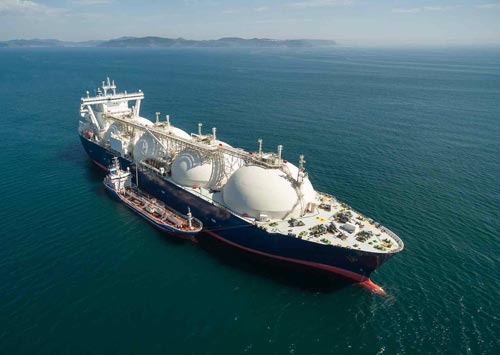The Design, Features, and Role of LPG Ships in Global Trade

An LPG ship (Liquefied Petroleum Gas Ship) is a type of tanker vessel specifically designed to transport liquefied petroleum gas (LPG), which includes gases like propane and butane in their liquid form. LPG ships are specially built to safely carry these highly flammable and pressurized gases, which are used in a variety of industries, including residential heating, cooking, and as fuel for vehicles, as well as for industrial and petrochemical applications.
Key Features of an LPG Ship:
Cargo Tanks:
LPG ships are equipped with pressurized cargo tanks to store the liquefied gases at high pressure or low temperature, depending on the type of LPG being transported.
The tanks are typically spherical or cylindrical in shape to withstand the pressure and ensure the safe storage of the gas. Some ships use Moss-type spherical tanks, which are popular for carrying LPG, while others may use membrane tanks or type C tanks.
Temperature and Pressure Control:
LPG is stored either at low temperatures (refrigerated) or under high pressure to keep it in a liquid state.
- For propane, the gas is typically stored at temperatures of around -42°C and pressures of about 7-8 bar.
- For butane, it may be stored at a slightly higher temperature and pressure.
The ship has a system to monitor and regulate the pressure and temperature to prevent the gas from vaporizing.
Safety Features:
LPG ships are built with stringent safety measures due to the highly flammable nature of LPG. These include:
- Pressure relief valves to prevent over-pressurization.
- Double hulls to minimize the risk of leaks or spills in case of an accident.
- Gas detection systems and fire suppression systems.
- Inert gas systems to ensure that the cargo tanks are filled with a non-combustible gas (like nitrogen) to reduce the risk of explosion.
Cargo Handling and Loading/Unloading:
LPG ships are equipped with piping systems, cargo pumps, and valves to load and unload the LPG safely at terminals. The gas is usually transferred via pipelines or hoses to and from the ship.
Loading arms and transfer pumps are used at ports, and these systems ensure the LPG is safely transferred while minimizing the risk of leaks.
Size and Types of LPG Ships:
Handysize:
Small LPG carriers with capacities around 5,000 to 15,000 cubic meters (cbm) of LPG. These are typically used for regional and short-distance transportation.
Medium:
Larger vessels, usually with capacities between 15,000 and 45,000 cbm.
Large (VLGC):
Very Large Gas Carriers typically range from 45,000 to 85,000 cbm and are used for long-haul transportation of LPG. These are the most common type of LPG carriers and can carry large volumes over vast distances, often between continents.
Shipping Routes:
LPG ships are primarily used for international trade, transporting LPG from production countries (like the United States, Qatar, and Russia) to consumer markets (such as Europe, Japan, and India).
These ships often dock at specialized LPG terminals at ports, which have the infrastructure to handle the loading and unloading of LPG.
Crew and Operations:
The crew of an LPG ship is highly trained to handle the specific risks associated with transporting hazardous gases. Crew members must be familiar with the operation of gas systems, safety protocols, and emergency procedures.
Environmental Considerations:
Although LPG is a cleaner-burning fuel compared to other hydrocarbons like coal or oil, LPG carriers still need to comply with international environmental regulations regarding emissions, waste disposal, and ballast water management.
An LPG ship is a specialized vessel designed to safely transport liquefied petroleum gas (LPG) across seas and oceans. These ships are equipped with pressurized or refrigerated tanks to store the gas, and they are built with stringent safety features to manage the high risks associated with carrying such flammable substances. LPG ships play a crucial role in the global energy market, facilitating the transportation of propane and butane for use in domestic, industrial, and commercial applications worldwide.
Search Jobs
Seagoing Jobs
- Deck Officer Jobs (41)
- Deck Rating Jobs (7)
- Engineering Officer Jobs (71)
- Engineering Rating Jobs (1)
- Catering Rating Jobs (5)
- Specialist Jobs (3)
- Other Maritime Jobs (38)
Shore Side Jobs
- Shore Side Jobs (15)
Offshore Jobs
- Offshore Jobs (4)
- Drilling / Rig Jobs (0)
- ROV/Diving Jobs (0)
- Production Jobs (0)
- Oilfield Services Jobs (0)
- Procurement & Construction Jobs (0)
- Engineering & Science Jobs (0)
- Geosciences Jobs (0)
- Maintenance & Inspection Jobs (0)
- Health, Safety & Environment Jobs (1)
- Refining & Petrochem Jobs (0)
- Business, IT, HR & Admin Jobs (0)
- Trades & Technicians Jobs (1)
- Other Offshore Jobs (0)

Share this page: